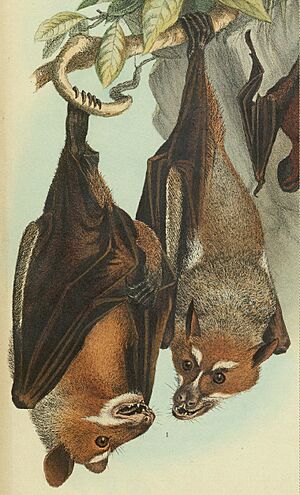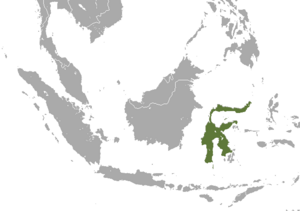Sulawesi stripe-faced fruit bat facts for kids
Quick facts for kids Sulawesi stripe-faced fruit bat |
|
|---|---|
 |
|
| Conservation status | |
| Scientific classification | |
| Genus: |
Styloctenium
|
| Species: |
wallacei
|
 |
|
| Sulawesi stripe-faced fruit bat range | |
| Synonyms | |
|
Pteropus wallacei Gray, 1866 |
|
The Wallace's or Sulawesi stripe-faced fruit bat (Styloctenium wallacei) is a type of large bat. It belongs to the Pteropodidae family, which includes fruit bats. This bat lives only in Sulawesi and the nearby Togian Islands in Indonesia. Interestingly, ancient cave paintings in Australia look like these bats. However, bats like this are not found in Australia today.
Contents
Discovering the Sulawesi Stripe-faced Fruit Bat
The Sulawesi stripe-faced fruit bat was first officially described in 1866. A British zoologist named John Edward Gray gave it the name Pteropus wallacei. He named it after Alfred Russel Wallace, another British naturalist. Wallace had found the first bat specimen in Sulawesi, Indonesia.
How Scientists Classified This Bat
When Wallace found the bat, he was sure it was a new species. But some scientists thought it was just a young masked flying fox. Later, in 1899, a German zoologist named Paul Matschie moved the bat to a new group called Styloctenium. For a long time, scientists thought this group had only one species.
Finding a New Stripe-faced Bat
Then, in 2007, a new bat was found on Mindoro island in the Philippines. It was described by Jacob Esselstyn. This bat, called the Mindoro stripe-faced fruit bat (Styloctenium mindorensis), was added to the Styloctenium group. This meant the group now had two known species.
What Does the Sulawesi Stripe-faced Fruit Bat Look Like?
The Sulawesi stripe-faced fruit bat is a typical fruit bat. It has long, hairless ears. Its front limbs are shaped like wings for flying. It also has short back legs with claws.
Unique Facial Markings
This bat has special white markings on its face. Each white mark has a dark brown edge. There is a streak on its nose area and a spot on its cheek. Another spot is found at the corner of its jaw. It also has a patch above its eye, a band across its upper lip, and a patch on its chin. The Mindoro stripe-faced fruit bat is different because its lower and upper canine teeth have multiple points.
Where Do These Bats Live?
The Sulawesi stripe-faced fruit bat lives on the island of Sulawesi in Indonesia. It also lives on the Togian Islands. These islands are located in the Gulf of Tomini.
Their Forest Home
These bats prefer to live in primary forest, which is old, untouched forest. They can be found at heights up to about 1,100 meters (3,600 feet). Sometimes, they are seen in secondary forests. These are forests where the undergrowth has been cleared for growing crops like coffee or cocoa. If you see them in open areas, they are likely flying between different parts of the forest.
Ancient Bat Paintings
Interestingly, Cave paintings of large bats have been found near Kimberley in Australia. These paintings do not look like any bats living in Australia today. Instead, they look more like the Sulawesi stripe-faced fruit bat. Scientists have tested a fossilized wasp nest covering some of these paintings. It was found to be 17,500 years old. This suggests the rock art is even older, possibly from the last ice age, about 20,000 to 25,000 years ago.
What is the Bat's Conservation Status?
The Sulawesi stripe-faced fruit bat is common in some parts of Sulawesi. However, it is rare in other areas. A lot of the primary forest on Sulawesi has been cut down for farming. This means the bat's population is likely getting smaller. People might also hunt these bats in some places.
Protecting the Species
Because of these reasons, the International Union for Conservation of Nature (IUCN) has listed this bat as "near threatened." This means it could become endangered if its situation does not improve. The bat can be found in the Lore Lindu National Park in Central Sulawesi, which helps protect some of its habitat.
Images for kids




